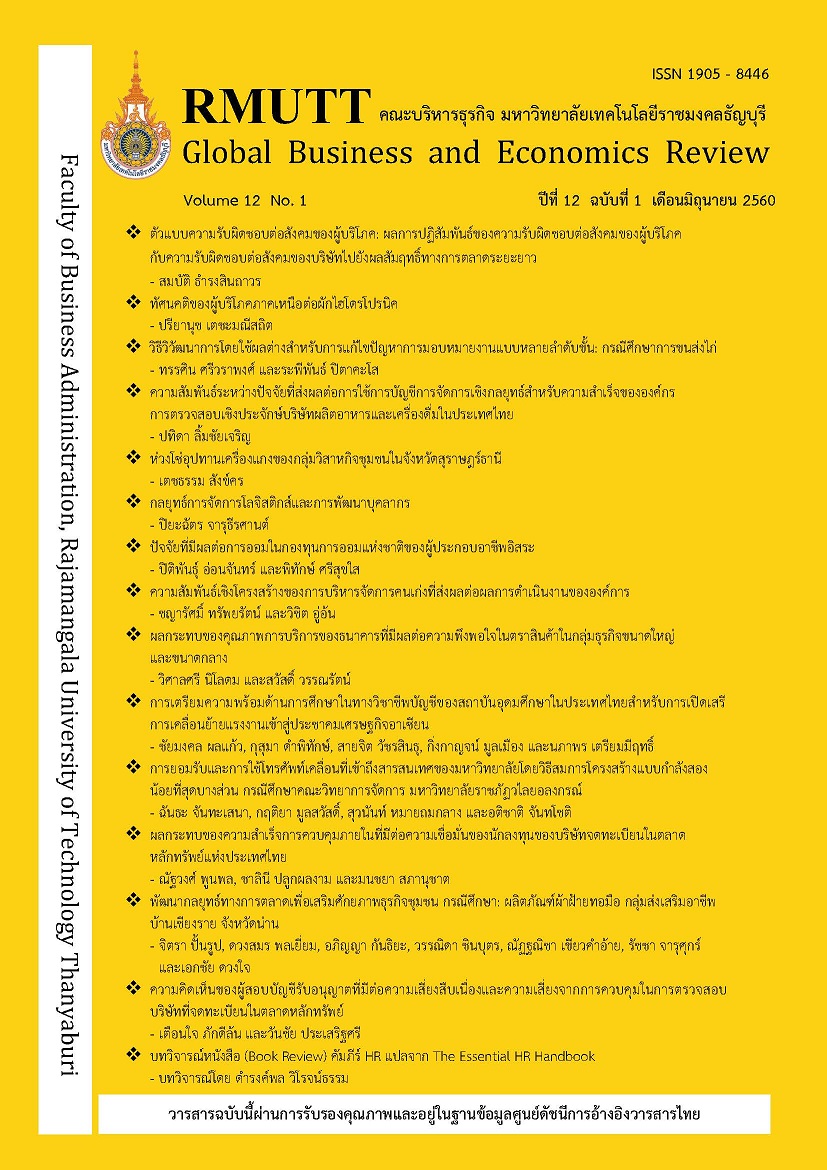THE EFFECTS OF SERVICE QUALITY BANKING ON BRAND SATISFACTION IN LARGE AND MID-SIZE COMPANIES
Keywords:
Client Satisfaction, Bank, Brand Perception, Brand SatisfactionAbstract
This study focuses on three objectives. Firstly, to study the service quality of a bank in Bangkok as experienced by its corporate client; secondly, to compare the service quality of a bank as experienced by large and medium size companies; lastly, to study the relationship between the bank’s service quality and brand satisfaction. The sample group consists of a medium size corporates, whose sales ranges from 1 to 4 billion Baht, and large corporates with sales over 4 billion Baht. All of them are Bangkok-based. The research was conducted using stratified sampling, with data collected from over 265 participants. The data was collected through questionnaires and analyzed using statistical software. Analyses were completed with the use of descriptive statistics, which composes of percentage, arithmetic means, standard deviation, t-Test and Pearson’s Correlation. The result demonstrates that there is no difference inlarge and medium-size corporate clients’ satisfaction regarding service quality. The study indicates that corporate clients’ satisfaction level concerning the bank’s service quality is considerably high. There is a positive relationship between the level of service quality and brand satisfaction.
References
ธนาคารแห่งประเทศไทย. (2557). Performance of the Thai Banking System in 2014. สืบค้นจาก https://www.bot.or.th/English/FinancialInstitutions/Publications/FIProformance_Pres s/n0958e.pdf)
อภิชาติ นาคะอุไร. (2554). คุณภาพในการให้บริการธนาคารทางโทรศัพท์มือถือของธนาคารไทยพาณิชย์ จำกัด (มหาชน). (การศึกษาค้นคว้าอิสระปริญญามหาบัณฑิต, มหาวิทยาลัยเกษตรศาสตร์)
Armstrong, R. W. & Seng, T. B. (2000). Corporate-customer satisfaction in the banking industry of Singapore. Journal of Bank Marketing, 18(3), 97-111.
Berry, L. L., Zeithaml, V. A., & Parasuraman, A. (1985). Quality counts in services, too. Business Horizons, 28(3), 44-52.
Berry, L. L.. (1990, Summer). Five imperatives for improving service quality. Sloan Management Review, pp. 29-38.
Cardozo, R. N. (1965). An experimental study of customer effort, expectation, and satisfaction. Journal of Marketing Research, 2, 244-249.
Kuhn, K. L., Alpert, F., & Pope, N. L. (2008). An application of keller’s brand equity model in a b2b context. Journal of Qualitative Market Research, 11(1), 40-58.
Nunnally, J. C. & Bernstein, I. H. (1995). Teoria psicometrica. Mexico: McGraw-Hill. Parasuraman, A. (1987). Costumer-oriented corporate cultures are crucial to services marketing success. Journal of Service Marketing, 1(1), 39-46.
Parasuraman, A. (1988). Future strategic emphases in service versus goods business. Journal of Service Marketing, 2(4), 57-66.
Parasuraman, A., Berry, L. L., & Zeithaml, V. A. (1991). Understanding customer expectations of service. Sloan Management Review, 39-48.
Voss, G. B., Parasuraman, A., & Grewal, D. (1998). The roles of price, performance, and expectations in determining satisfaction in service exchanges. Journal of Marketing, 62, 46-61.
Yamane, T. (1970). Statistics – an introductory analysis (2nd ed.). Tokyo: John Weather Hill.
Zeithaml, V. A., Berry, L. L., & Parasuraman, A. (1993, Winter). The nature and determinants of customer expectations of service. Journal of the Academy of Marketing Science, 21(1), 1-12.
Downloads
Published
How to Cite
Issue
Section
License
The articles published in this journal are the intellectual property of their respective authors.
The views and opinions expressed in each article are solely those of the individual authors and do not reflect the positions of Rajamangala University of Technology Thanyaburi or any of its faculty members. All components and content of each article are the sole responsibility of the respective authors. In the event of any errors, the authors shall bear full responsibility for their own work.








